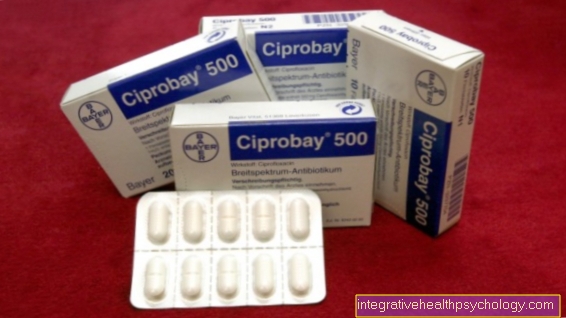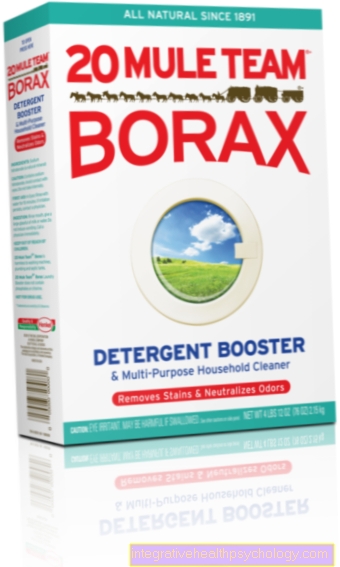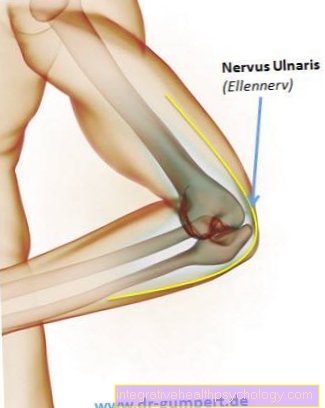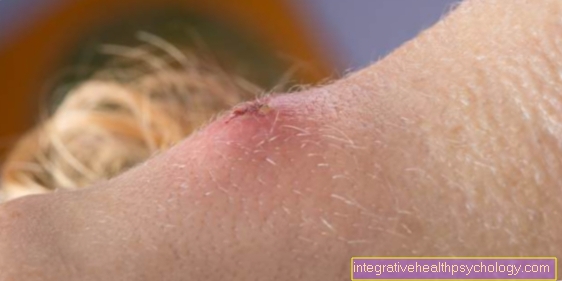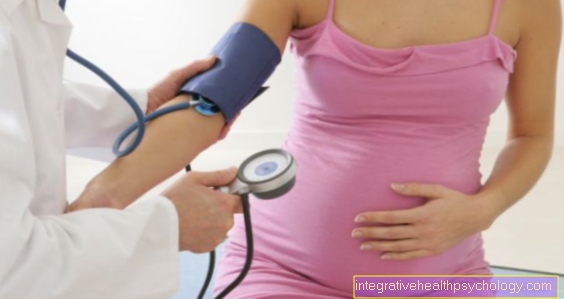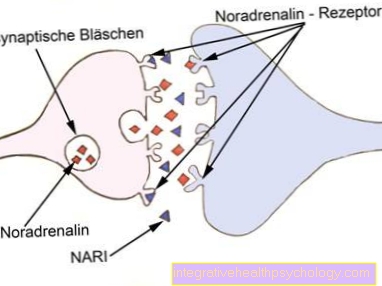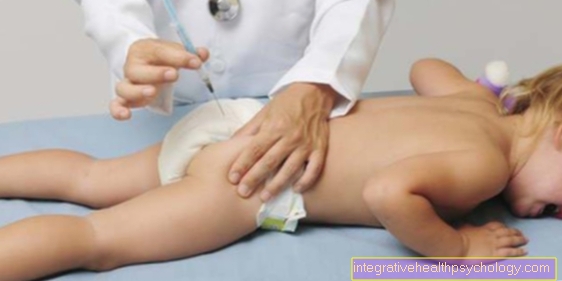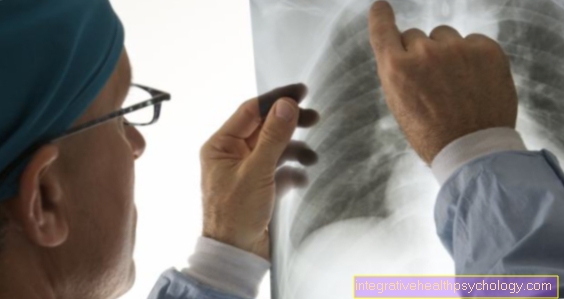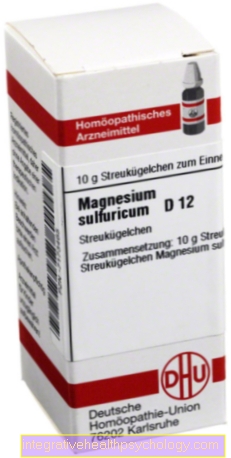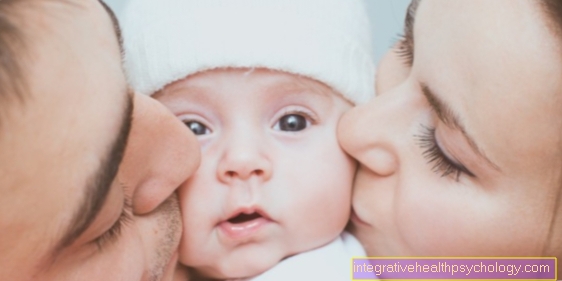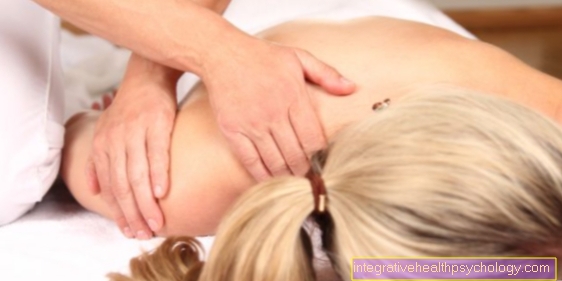Fever in the toddler
definition
In small children, a fever is a body temperature of over 38 ° C, a high fever is understood to be temperatures of over 39 ° C, whereby more than 41 ° C can be life-threatening, as it can destroy the body's own proteins. The normal body temperature for small children should be between 36.5 and 37.5 ° C, whereby the rectal temperature measurement for babies or infants is the most reliable and accurate. At 0.5 ° C, the fever limit is slightly below that of adults, who only speak of fever above 38.5 ° C.
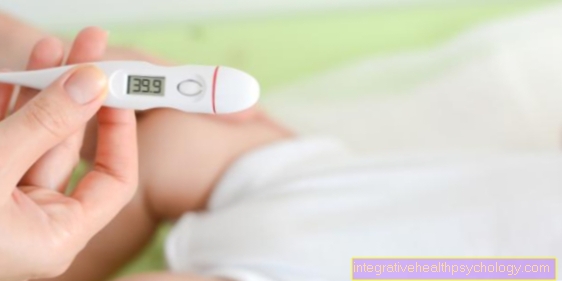
However, fever itself is not an independent disease, but a reaction of the body to a pathological event, so that it should rather be referred to as a symptom. The aim of upregulating the core body temperature is to optimize the circumstances for the body's own defense processes so that, for example, the cells and enzymes involved in the defense against bacteria and viruses can function more effectively and faster.
The control center for body temperature regulation is the brain's hypothalamus, which continuously measures the current actual temperature and adapts it to the target temperature. If the hypothalamus receives the information that the immune system has to be activated by certain illnesses (such as inflammation or infections), it is therefore able to activate the muscles (shivering cold, chills), narrowing of the blood vessels and - especially only possible in young children - the production of heat in the brown adipose tissue, the body temperature increase and the baby get a fever.
It is important, however, that especially with the youngest, the body temperature can fluctuate more strongly throughout the day than with adults, so that not every slight increase in temperature should cause concern for the parents. However, if the increase in temperature lasts longer than 3 days, a pediatrician should be consulted as early as possible, who can initiate a cause research and therapy.
However, you should urgently refrain from attempting to lower your fever by means of medication, as not all fever-lowering medications common to adults are also suitable for small children! As a rule of thumb, babies under 3 months should consult the pediatrician quickly from a temperature of> 38 ° C, babies over 3 months from> 39 ° C.
When do you start talking about a fever in a toddler?
In small children, a body temperature of 38.5 ° C or more is referred to as fever. Subfebrile temperatures are used when the temperature is clearly higher but still below 38.5 ° C. There are different statements from when one speaks of subfebrile temperatures, as temperatures above 37.0 ° C can be normal. Subfebrile temperatures are definitely used above 37.5 ° C. From a temperature of 39.0 ° C we speak of a high fever. From a temperature of 41.0 ° C we speak of life-threatening fever.
However, not every increased body temperature must indicate an illness. During the day, the body temperature fluctuates by around 0.5 ° C. Even with increased physical activity (for example a lot of romping), an increased body temperature can occur. Infants can have serious infections even without a fever. Here, a normal body temperature is not a reliable criterion for excluding serious illnesses. The most accurate and most reliable fever measurement is obtained rectally (in the buttocks).
Read more on the subject at: How can you measure a fever?
When does it get dangerous?
A high fever (39.0 ° C) is not necessarily dangerous. A life-threatening fever is only spoken of at temperatures above 41.0 ° C. From this temperature there is a risk that the body's own proteins (Proteins) can be damaged, leading to organ malfunction. Since the fever can rise quickly under certain circumstances, it is important to measure the fever at regular intervals. in order to be able to react quickly when it rises.
Any fever that cannot be reduced with medication is also to be regarded as dangerous. A febrile seizure is also considered to be potentially dangerous. In addition, accompanying symptoms such as repeated vomiting, no longer wanting to drink and lethargy should be observed. A fever should generally only be reduced with medication from a temperature of 39.0 ° C. If a febrile seizure has already occurred, the fever should be reduced with medication at a temperature of 38.5 ° C.
Read more on the subject at:
- Febrile seizure
- When should I see a doctor with a fever?
When should I see a doctor with my child?
In general, a pediatrician should be consulted if the temperature exceeds 39.0 ° C. If the fever cannot be lowered, a doctor should be consulted. If the fever persists for more than a day in a child under two years of age or for more than three days in a child over two years of age, a pediatrician should also be consulted. A pediatrician should also be seen if a toddler experiences symptoms such as lethargy, repeated vomiting, severe diarrhea, rash, reluctance to drink two or more meals, or other unusual behavior. In general, it is sufficient to see a resident pediatrician instead of going to the emergency room. Usually 90% of the cases can be resolved here.
Causes of fever in toddlers
The fever of young children can have a variety of causes, with various infectious diseases and inflammations being the most common. Since the immune system is not yet fully developed after birth and is still in the learning phase for some time, babies and toddlers in particular fall ill more often and more easily. In most cases, the carrier is your own parents and infected toys. The entry portals with the most contact with the environment are most often infested, so that the mucous membranes of the nose, throat and ear are often infected by viruses or bacteria. Many of the infections of the upper respiratory tract or the ears then usually show a fever as well as a cough, runny nose, ear pain and sore throat.
Likewise, infections of the gastrointestinal tract are usually accompanied by fever, diarrhea, abdominal pain and vomiting. In the same way, urinary tract infections, bacterial inflammation of the bones or joints, and rheumatic fever can also trigger an increase in body temperature. The latter is a reaction of the immune system to an infection with streptococci such as scarlet fever, tonsillitis or otitis media.
Child infections such as measles, chickenpox, rubella, mumps, etc., can always cause the classic skin rashes accompanied by fever as a further cause. The so-called three-day fever is also a frequent trigger of febrile episodes in small children, which usually last 3 days, can be detached from a rash and often trigger an uncomplicated febrile seizure, but are usually harmless.
In spite of everything, in rare cases more serious infections can be behind a persistently high fever, as can be the case, for example, with meningitis caused by meningococci or leukemia. A feverish reaction to any vaccinations is also possible, but in most cases this should not cause concern. After injecting the vaccine serum, the infant's immune system is activated and the defense of the respective pathogen trained, which can lead to increased body temperatures for a short time.
One of the very common triggers of a sudden onset of fever without accompanying cold symptoms is teething, in which babies can have a wide variety of symptoms.
Other common signs of the eruption of the first teeth are usually
- flushed cheeks,
- reddened gums,
- changed bowel habits (flatulence, diarrhea or constipation),
- Teething rash in the baby
- Loss of appetite
- and the repeated sticking of fingers and objects in the mouth.
Read more on the topic: Causes of fever
teething
The first teeth usually appear at the age of six months, and the deciduous teeth are complete by around three years of age. The typical symptoms of teething also include those that would otherwise indicate an infection. The cheeks may be red and hot, the child is restless and sleeps poorly, has less appetite. In some cases, fever and diarrhea can also occur. In general, there is no need to worry here, even if there is sometimes a small infection. This can happen because teething temporarily weakens the immune system. However, if the child has a high fever, persistent fever, or severe diarrhea, the child should be presented to the pediatrician.
Read more on the subject at: Teething in the baby
Duration of fever in the toddler
Young children are much more likely to have a fever than adults. Usually this is due to a harmless infection, which means that the fever quickly subsides. In children between the ages of one and two years, a fever usually subsides after a day. If the fever lasts longer, a pediatrician should be consulted, as specific treatment of the cause may be necessary (e.g. in the case of bacterial infections with antibiotics). In children over two years of age, the fever can last up to three days before a pediatrician should be seen.
The duration of a fever can provide clues as to the underlying cause. Read more about the duration of a fever on the following page: How long does a fever last?
Symptoms
Whether the fever develops is usually noticed by the parents during the phase of the rise in temperature, when a clearly warmed forehead is noticeable when stroking the head, while the rest of the body still appears normal. Since the toddler feels uncomfortable, but cannot yet convey this, it is primarily noticeable through crying and whining. In some cases, chills can even be felt. Once the fever has peaked, the little ones will notice their glowing red cheeks and a rise in temperature, especially on the stomach and back, which can later be felt all over the body. Restlessness at night, waking up frequently at night, and breathing quickly can also be signs of a fever.
If the fever gradually subsides, the classic sweating begins and the toddler is increasingly tired and limp. If the toddler can be reassured to some extent at all times and if the intake of food and fluids is not reduced at any time, no major concerns need to arise initially. However, it becomes increasingly unusual, cannot be calmed down by anything, does not respond well to speech, appears apathetic, stops drinking and eating, has a dry mouth or even begins to cramp if a pediatrician should be consulted promptly. If you experience abdominal pain, vomiting, diarrhea or skin rashes, you should go to the pediatrician.
Read more on the topic Vomiting in the toddler such as Feverish dream
diagnosis
The body temperature can be measured with a clinical thermometer either rectally in the buttocks, or orally in the mouth, as well as in the armpit or in the ear. However, the rectal measurement is recommended for young children as this is by far the most accurate. Only in children over the age of 5 should measurements be taken by mouth. The measurements in the ear and armpit usually deviate by 0.5 ° C from the actual body temperature and can thus falsify the true value, which can quickly lead to excessive temperatures being overlooked, especially with small children.
Read more on the topic: Measure a fever, how do I know if my fever is contagious?
Therapy of fever in young children
There are two easy ways to help a feverish toddler. For one thing, simple, non-drug measures can help lower the fever and make the baby feel unwell. Care should be taken that the toddler is not dressed too warmly and covered during the fever, so that a thin romper or a light cotton cloth is usually sufficient to cover it. Nevertheless, care should be taken that the little ones do not cool down in the sweaty phase with damp clothing, so that it is important to change their sweaty clothes regularly.
The cooling effect of moist calf compresses (wrap cotton towels around the small child's calves at 20 ° C) can also reduce fever. In addition, you should ensure that you drink enough (breast milk, water) to protect the baby from dehydration. Regular control of the temperature is important in order to be able to assess the course of the fever and, if necessary, to consult a pediatrician at the right time.
Whether drug treatment of the fever is necessary and initiated should be decided by the treating pediatrician alone. Independent treatment with drugs is generally not recommended. The common drugs prescribed by the doctor are usually so-called antipyretics, which, in addition to lowering fever, also reduce pain and inflammation (paracetamol, ibuprofen). These are usually administered in a form adapted for small children, such as. B. as fever juice or rectal fever suppositories. The administration of ASA / Aspirin® (acetylsalicylic acid) should be avoided, as this drug - unlike in adults - can trigger the life-threatening Reye's syndrome in babies, which is characterized by a serious disease of the liver and brain.
Read more on the topic: What to do if your baby has a fever
You might also be interested in: Fever suppositories for babies and children
What is the best way to lower a fever?
A fever should be reduced in children from 39.0 ° C (according to some sources from 39.5 ° C). Sometimes a fever lowering from 38.5 ° C is recommended if a febrile seizure has already occurred. This is not absolutely necessary, since lowering the fever early cannot prevent another febrile seizure. Lowering the fever is often not necessary at lower temperatures, as the fever is a natural reaction of the body to a stimulus, usually an infection, and can help fight it. The most important factor, however, is the child's health. If a child is already severely restricted with a slight fever, the fever can be lowered.
The best means to reduce a fever are fever-lowering suppositories or juices that are specifically suitable for children, as well as various home remedies. For example, paracetamol juice (Benuron®) can be used. Alternatively, ibuprofen juices (Nurofen®, Ibuflam®, Iburon®) can be taken. For the exact application please see the package insert, the dosage depends on age and weight. The use of Novalgin® (active ingredient: metamizole) is not recommended for children! Aspirin® (active ingredient: ASA = acetylsalicylic acid) should never be used in children! It is also important to drink enough fluids (water, tea).
Read more on the subject at: How can you lower a fever?
Home remedies
The most central and most important measure is to react to the child's temperature needs. If hands and feet become cold or if there is chills, the child should be wrapped up warm. If there is a fever plateau (constant temperature) or if the fever drops, a build-up of heat should be avoided. To do this, the child must not be dressed / covered too warmly so that heat can escape. Calf wraps (moist and lukewarm, never wet and ice cold) can also be used here or, alternatively, a damp cloth on the forehead. In addition, it should be ensured at all times that the child drinks enough.
Find out everything about the topic here: Calf wrap against fever
Common home remedies are also onion juice and onion wraps, as well as preparing various teas. Lime blossom teas and elderflower teas in particular are considered to be good antipyretic. If you are unsure or have questions about the tolerance of sensitive children and allergies, you should always consult your pediatrician.
prophylaxis
As a rule, it is hardly possible to completely protect small children from one or the other fever episode fever In order to avoid this, the causative infection or inflammation must be prevented. According to research, however, it has been found that babies who have been breastfed to the end, the complete immunological maternity protection via the antibodies contained in breast milk received and are thereby increasingly supported in their immune defense. Febrile infectious diseases then occur in the Transition periodin which the toddler is still no fully developed, own immune defense system owns, significantly less.
In addition, a If the parents have an acute cold, direct contact with the child should be avoidedto avoid contracting febrile infections.
Complications
Especially with small children it can easily become too fast, too strong dehydration come during the fever / sweating, which is due to the very large body surface area compared to body weight. If it refuses to drink at the same time, it can quickly become Dehydration (Dehydration) come. Signs of this can on the one hand Failure to wet the diaper within the last 6 hours or a very dark yellow urine be, on the other hand also one Dryness of the lips and tongue such as Missing tears when crying and a sunken fontanel.
For some toddlers between the 5th month and 6th year of life From a temperature of> 38 ° C, a Febrile seizure (epileptic occasional seizure), the cause of which has not yet been precisely clarified, but this one definitely not on a course of illness in brain of the toddler. A genetic predisposition for excessive discharge is suspected Neurons with increased body temperature. The circumstances that the toddler twitches in the arms, legs or face during the cramp, rolls his eyes, takes a short break, and possibly even blue lips in the event of a loss of consciousness can be very disturbing and frightening to the parents.
However, a distinction is made between that uncomplicated, one-time febrile seizurethat lasts less than 15 minutes and disappears by itself, and the complicated febrile seizure, of the longer than 15 minutes lasts within 24h multiple times occurs and permanent neurological damage (development of a epilepsy possible). In 90% of the cases the febrile seizure stops by itself without therapeutic measures and does not occur again in the following 24 hours.
Can I bathe my child?
In principle, it is possible to bathe a toddler with a fever. If the child does not want to bathe under any circumstances, this can also be avoided. There are a few important things to keep in mind. First of all, the child should never be left unattended. In the worst case, it could lead to a febrile seizure in which the child slips underwater. Accordingly, the water should not be let too deep into the tub. The water should be lukewarm, water that is too warm can make a fever worse, and if the water is too cold, children with a fever can cool down very quickly.
If a bath salt, medicinal bath or the like is used, it must be ensured that it is approved for children. Overall, small amounts should be used. However, there are some good products that pharmacies and pediatricians can advise on. The bath should not last longer than ten minutes and it must be ensured that the child is then dried off well and wrapped up warm (for example in bed) to prevent hypothermia.





